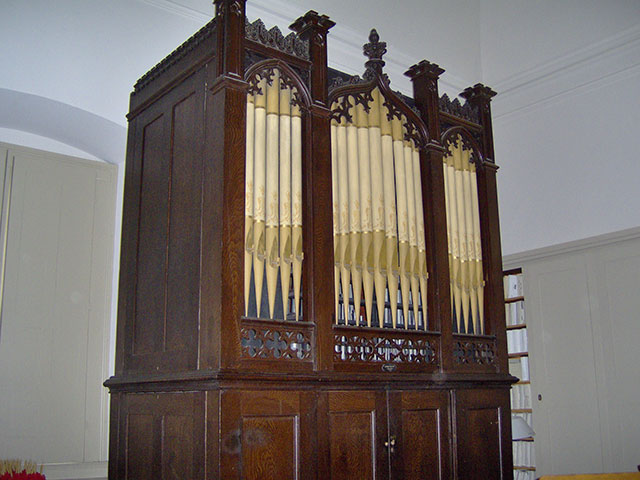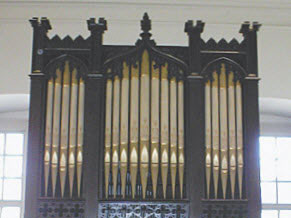| Left Jam | |
|---|---|
| 8' | Open Diapason |
| 8' | Dulciana TF |
| 8' | Stopped Diapason Treble TF |
| 8' | Stopped Diapason Bass |
| Swell | |
|---|---|
| 8' | Gamba TF |
| 4' | Principal |
| 2' | Flageolet |
Pedal - Coupler only from manual
Manual Compass- 56 keys- C1 to G5
Pedal Compass- 20 pedals - C1 to G2
Pitch - A 450
Wind 3 1/2" - 1/3 HP blower
History
This instrument was built in 1857 by Henry Erben (1800-1884), considered by many organ historians to be the the preeminent maker in the United States in the middle of the nineteenth century. In 1816 he became apprentice to Thomas Hall, one of the nation's leading organ builders at the time. In 1824 he became Hall's partner, and in 1827, the sole owner of the business. Over the next six decades Erben's company produced hundreds of instruments that were installed in practically every state in the union.
Given the musical tradition of the Moravians, it is not at all surprising that the Bethlehem Congregation turned to Henry Erben to provide a new organ in the mid-1850s when it decided to start using the 1751 Old Chapel once more for worship services. The Old Chapel, the second place of worship for the congregation after the 1741 Gemeinhaus Saal, was used for worship services until May, 1806, when Central Church was completed. For the next several decades the Old Chapel served at various times as the church archives, a concert hall, and a place for school functions. In 1856 it was remodeled and once more became a regular place of worship.
In 1759 Johann Klemm and David Tannenberg had installed an organ in the Old Chapel. It may have been the immediate predecessor of the 1857 Erben organ. Obviously, a new organ was needed if the Old Chapel was to function effectively as a place of worship. It appears that Henry Erben himself was on hand when his new organ was installed in June of 1857. A church financial ledger carries two entries for June 23, 1857 which suggested that the organ cost a total of $1,050, which is consistent with what is known about the cost of Erben organs.
In the 1830s, Erben charged $475 for a one-manual organ with four ranks-the smallest organ he recommended for accompanying congregational singing and a choir. The four stops of his basic organ were open and stopped diapasons, principal, and fifteenth. If stops five, six, and seven were to be added, Erben suggested flute, twelfth, and dulcian, which would bring the cost up to $750. The 1857 Erben made for the Old Chapel has seven stops: 8' open diapason, 8' stopped diapason bass, 8' stopped diapason treble, 8' dulciana, 8' gamba, 4' principal , and 2' flageolet (fifteenth). The twenty-note pedal is a coupler only; there are no separate pedal stops. Erben's typical eight-stop organ of the 1830s had dimensions of 11' high, 7' wide, and 4' deep. This 1857 seven-stop organ has dimensions of 11'-9" high, 7'-6" wide, and 4'-2" deep. In 1976 David Beaty of the Hartman-Beaty Organ Company inspected the organ prior to an anticipated but never realized restoration. He described the black walnut and fake-grained pine instrument as being "porcupine Gothic" in style.
Some confusion about the date of acquisition of the organ for the Old Chapel has existed since J. Mortimer Levering's monumental history of Bethlehem was published about a hundred years ago. In what was surely a typographical error, Levering's book stated that "The organ at present in use [in the Old chapel] was built in 1859, and used the first time on June 28 of that year." Subsequent writers have repeated the mistake of giving 1859 instead of 1857 as the year the organ was installed. The handsome nameplate is clearly engraved with the year 1857.
In the early morning hours of November 29, 1941, fire damaged the west end and badly scorched all the interior surfaces of Central Church, which had just undergone a lengthy renovation. From then until May 2, 1942, services were held in the Old Chapel. Jeanette Zug, in her monograph about the Old Chapel, reminisced that "The venerable 1859 [sic] organ, which as school children we tried to pump and play, gave out when, after the 1941 fire in Central Church, all services were held in the Old chapel during Central's renovation." The exact date the Erben organ "gave out" is not known. The Bethlehem Diary for January 31, 1943, says "This evening Bishop S. H. Gapp, President of the P.E.C. [Provincial Elders Conference] dedicated the organ which was recently installed in the old chapel and which was purchased by the Busy Workers of the Central church at a cost of $5200 plus taxes. A service of music followed the consecration." At this time Byron K. Horne was pastor and Ifor Jones the organist and choir director of Central Church.
The newspapers - all dated 1942, from June 13 through December 13, and from various cities: Allentown, Bethlehem, Erie, and Philadelphia in Pennsylvania, and Dallas, Texas were used to wrap the pipes and other parts of the Erben organ. This confirms the time of the organ's demise.
Thus, after eighty-five years of service, the Erben organ was dismantled and placed in storage, until its resurrection in 1995, made possible through the generosity of Alma Musselman, whose sister, Nellie, was a leading figure in the musical life of the Bethlehem congregation for many years.
In 1991, Herbert P. Hartman was engaged by Central Moravian Church to reconstruct the Erben pipe organ, which was still in storage at the church. Mr. Hartman's restoration uses all the original parts with the exception of the reservoir and hand-pumped feeders. A small external blower has been used to supply wind to the instrument, and a platform upon which to place the instrument was constructed. All metal pipes, with the exception of the larger zinc ones, are cone-tuned or tuned at the mouth with extended ears; this was the practice of early builders before the introduction of tuning slides. The manual consists of 56 notes and has direct mechanical connection to the pallet valves in the chestwork. By additional mechanical connection, the lowest 20 notes of the manual are capable of being played by the pedalboard.

